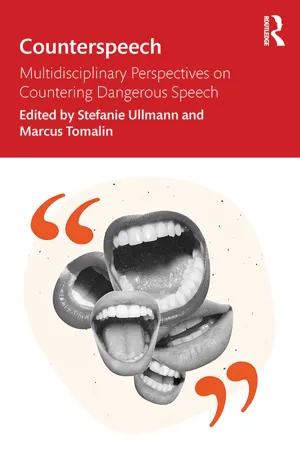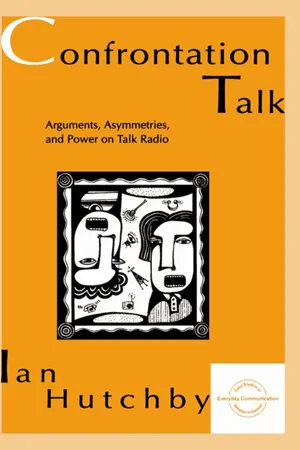Languages & Linguistics
Counter Argument
A counter-argument is an argument that opposes or disagrees with the main argument. It is used to anticipate and respond to objections that an opponent might raise. In language and linguistics, counter-arguments are often used in debates and discussions to strengthen one's argument.
Written by Perlego with AI-assistance
Related key terms
Related key terms
1 of 4
Related key terms
1 of 3
3 Key excerpts on "Counter Argument"
- eBook - ePub
Counterspeech
Multidisciplinary Perspectives on Countering Dangerous Speech
- Stefanie Ullmann, Marcus Tomalin(Authors)
- 2023(Publication Date)
- Routledge(Publisher)
Gegenrede is embedded in larger communicative projects and activities and through which linguistic-communicative as well as interactive means this relation is established, so that these are also recognizable for all those involved in the interaction. Counterspeech in the modeled understanding, as shown by the findings from the corpora, as well as the discussion of previous scientific research, contains a moral-normative dimension, which also emerges through indicators on the linguistic surface in interaction with the contextual factors.Figure 1.3 Different definitions and semantic distinctions of the concept “counterspeech”/Gegenrede.Nadine Strossen’s view on counterspeech corresponds to the second reading opposition to antecedent, but she emphasizes that counterspeech is not a means that must necessarily confront hate speech but that counterspeech is the central procedure that can be used on any topic circulating in the “marketplace of ideas”:- “The term ‘counterspeech’ encompasses any speech that counters a message with which one disagrees” (Strossen 2018 , 158).
- “This term refers to any speech that counters or responds to speech with a message that the speaker rejects, including ‘hate speech’” (Strossen 2018 , xxii).
From a legal perspective, which would like to restrict freedom of speech as little as possible, this broad definition may be appropriate, but as an analytical category, to say something about the specific practices of counterspeech, in my opinion it is necessary to apply some further criteria. I would like to present these criteria in the following section in a working definition. - eBook - ePub
Confrontation Talk
Arguments, Asymmetries, and Power on Talk Radio
- Ian Hutchby(Author)
- 2013(Publication Date)
- Routledge(Publisher)
2 AnalyzingArgumentIn this chapter, I embark on the task of analysis by developing a model of arguments as interactional accomplishments. This will be done by focusing first on the building of opposition in conversational disputes. I will suggest that arguments can be viewed as constructed by means of a basic Action-Opposition sequence, which can be chained by a given Opposition move being treated as the Action move of a next sequence. Noting that opposition in conversational disputes may be mitigated or highlighted using different turn formats, I will move on to look at how the specialized speech-exchange systems operative in many institutionalized contexts for disputes lead to those disputes being systematically mitigated in various ways. Only after this will I bring in the talk radio data, and show that in terms of the Action-Opposition sequence, talk radio is a relatively conversational dispute form which nonetheless takes place within a stable institutionalized discourse framework.ARGUMENT: THE ROLE OF OPPOSITION
“Argument” is a term that has numerous uses in ordinary language. As O’Keefe (1977) notes, we can speak of “making” an argument (putting a case for some position) and of “having” an argument (arguing with someone). This distinction is echoed in Schiffrin’s (1985) more technical categories of “rhetorical” and “oppositional” argument. By rhetorical arguments, Schiffrin means single turns in which “a speaker presents an intact monologue supporting a disputable position” (p. 37). Oppositional argument occurs when two or more speakers openly engage in disputing over a position across a series of turns.There may, however, be danger in sustaining too sharp an analytic distinction between making and having an argument. For one thing, as Jacobs and Jackson (1981) point out, rhetorical arguments can of course become part of oppositional arguments as speakers’ positions are contested and opposing positions are taken up and argued for. Moreover, even rhetorical arguments are produced in some interactional context, and are addressed in particularized ways to intended recipients. They may seek to construct for their audiences a restricted field of interpretation, by deploying what Witten (1992) describes as “centripetal devices”: “structures of information that turn in on themselves, close meaning down, license or authorize a particular set of messages, discourage plural readings” (p. 20). But the function of these features of self-reinforcement is to persuade a recipient - eBook - ePub
- Driss Ablali, Guy Achard-Bayle, Driss Ablali, Guy Achard-Bayle(Authors)
- 2023(Publication Date)
- De Gruyter(Publisher)
logos with the aim to persuade, in which speech is also reason. These two trends – the linguistic study of figures, and argumentation in language – open up fertile fields of research, which are not however relevant to the present undertaking, which is to articulate the linguistics of discourse and, more specifically, the French Discourse Analysis trend and rhetorical argumentation.1 Theoretical insights
1.1 The place of discourse in argumentation theories: The new rhetoric and pragma-dialectics
It is perhaps not superfluous to recall that it was argumentation specialists who were initially interested in the linguistic aspect of their discipline. Indeed, faced with studies focused on argument and its logical validity (such as informal logic), we find trends whose central preoccupations were the communicational and linguistic aspect of rhetorical argumentation. The most notable example of this is the New rhetoric of Perelman/Olbrechts-Tyteca (1969). The authors start from the dynamic which links an orator and a listener, and they devote a major part of their study to the verbal aspect of techniques designed to elicit agreement. This study of the language elements which relate to the enunciative framework, to the addressee, the lexicon, hedges, qualifications, etc. – are highly valuable for analyzing persuasive discourse. However, as I have shown elsewhere (Amossy 2002), the study is nonetheless based on a notional system derived from a very traditional conception of linguistics and grammar. Furthermore, the chapter titled “Présentation des données et formes du discours” (‘Presentation of data and forms of discourse’) is not structured around a classification of arguments and topics which take pride of place; the two enterprises remain separate and autonomous. Consequently, the exploration of the role of language only indirectly casts light on the overall functioning of persuasive discourse and does not lead to a practice of analysis. In fact, this undertaking, as such, was of little interest to Chaïm Perelman; as a philosopher and a philosopher of law, he had only an occasional interest in language.
Index pages curate the most relevant extracts from our library of academic textbooks. They’ve been created using an in-house natural language model (NLM), each adding context and meaning to key research topics.
Explore more topic indexes
Explore more topic indexes
1 of 6
Explore more topic indexes
1 of 4


